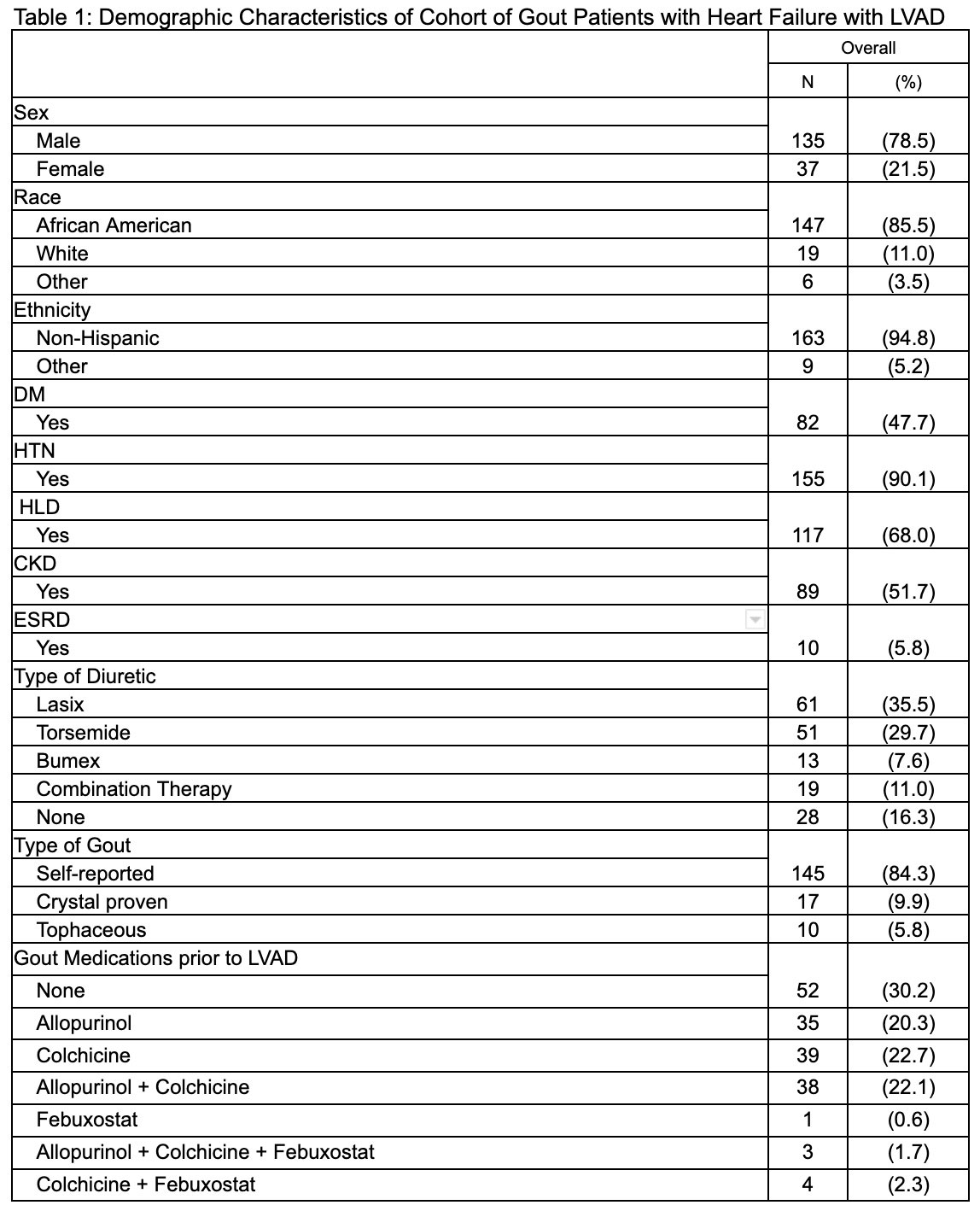Session Information
Date: Monday, November 14, 2022
Title: Metabolic and Crystal Arthropathies – Basic and Clinical Science Poster
Session Type: Poster Session D
Session Time: 1:00PM-3:00PM
Background/Purpose: Gout is one of the most common inflammatory joint diseases and is a disabling complication in patients with heart failure. Patients with gout and heart failure represent a high risk population with multiple admissions to the hospital. Recently, the left ventricular assist device (LVAD) has emerged as an alternative option to medical management of end stage heart failure. There is currently no data on gout flares and gout management in heart failure patients with LVAD.
The primary aim of our study was to look at prevalence of gout flares in this cohort in both inpatient and outpatient settings, analyze risk factors that contribute to gout flares and therapeutic options used for the treatment of gout flares in heart failure patients with LVAD.
Methods: We conducted a retrospective chart review of patients who had a diagnosis of heart failure with LVAD and diagnosis of gout (self reported, crystal proven, or tophaceous), seen in the inpatient or outpatient settings at a large academic center between January 2014 to January 2020. Statistical Analysis System software version 9.4 (SAS Institute Inc., Cary, NC, USA) was used to perform the analysis. Summary statistics were obtained for the overall sample. Pearson correlation test was used to assess association between two continuous variables. Linear regression was used to examine association between continuous variables and demographic variables. Statistical significance was defined as p-value < 0.05.
Results: A total of 174 patients’ charts were reviewed. The mean age of patients was 60.2 ± 10.3 years, predominantly male (78.5%). The mean BMI was 31.3 ± 6.8 kg/m2. The mean uric acid before LVAD placement was 8.6 ± 3.2 mg/dl and after LVAD placement was 7.8 ± 3.3 mg/dl. The average interval from LVAD placement to first flare was 10 ± 19.6 months. Analysis of diuretic usage in our cohort revealed that combination diuretic therapy significantly increased uric acid levels and incidence of flare post LVAD compared to monotherapy with Furosemide. There was no statistically significant difference in the uric acid and number of flares prior and post LVAD placement. There was also no correlation between uric acid levels prior to LVAD and number of flares post LVAD placement. However there was a positive correlation between those with increased flares prior to LVAD having increased flares post LVAD placement. It was also statistically significant that patients were more likely to be on appropriate medications for flares when Rheumatology was consulted.
Conclusion: This study concentrated on one of the largest cohorts of heart failure patients with LVAD in the country with diagnosis of gout. At the time of reporting this study, this is the largest study on a cohort of patients with LVAD and gout. Our study revealed that there is no difference in the frequency of gout flares prior and after LVAD placement, however there is positive correlation in increased flares prior to LVAD predicting increased flares in the future. As gout flares increase the morbidity, especially in these at risk patients with LVAD, there is a critical need for collaboration between cardiologists, heart failure specialists, and rheumatologists to manage these complex patients.
To cite this abstract in AMA style:
Arora A, Jayaram L, ESHETU T, CONSTANTINESCU F. Gout in Heart Failure Patients with Left Ventricular Assist Device Therapy in a Tertiary Academic Hospital [abstract]. Arthritis Rheumatol. 2022; 74 (suppl 9). https://acrabstracts.org/abstract/gout-in-heart-failure-patients-with-left-ventricular-assist-device-therapy-in-a-tertiary-academic-hospital/. Accessed .« Back to ACR Convergence 2022
ACR Meeting Abstracts - https://acrabstracts.org/abstract/gout-in-heart-failure-patients-with-left-ventricular-assist-device-therapy-in-a-tertiary-academic-hospital/


